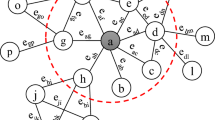Abstract
Graph is a simple but effective way to represent a complex system, where a node represents a component of the system and edge represents connection between the components. Several insights can be inferred by analyzing such graphs. In this field, optimization of spread and localization are relatively a new research domain. The objective of the spread problem is to maximize the influence, whereas localization controls the diffusion. In this paper, our focus is on the eigenvector localization of the network adjacency matrix using inverse participation ratio (IPR). In this context, we propose betweenness centrality-based perturbation (BP) to localize the network. The results show that the BP approach achieves a better localization than the existing random perturbation (RP) approach. It shows maximum IPR than RP. The performance of the approaches is evaluated using threshold rate of diffusion (τ), number of modifications and IPR. Susceptible–infected–susceptible model is used to investigate the τ value.





Similar content being viewed by others
Abbreviations
- IPR:
-
Inverse participation ratio
- SIS:
-
Susceptible–infected–susceptible
- SIR:
-
Susceptible–infected–recovered
- SI:
-
Susceptible–infected
- RP:
-
Random perturbation
- BP:
-
Betweenness centrality-based perturbation
- τ :
-
Rate of diffusion (threshold)
- NM:
-
Number of modifications
- PEV:
-
Principal eigenvector
- LEV:
-
Largest eigenvalue
- IPR*:
-
Optimal IPR
- BC:
-
Betweenness centrality
References
Amato F, Moscato V, Picariello A, Sperlí G (2019) Diffusion algorithms in multimedia social networks: a novel model. In: Kaya M, Alhajj R (eds) Influence and behavior analysis in social networks and social media. ASONAM 2018. Lecture notes in social networks. Springer, Cham
Barabási AL, Albert R (1999) Emergence of scaling in random networks. Science 286(5439):509–512
Bategaji V, Mrvar A (2006a) Pajek dataset. http://vlado.fmf.uni-lj.si/pub/networks/data/
Bategaji V, Mrvar A (2006b) Pajek dataset. http://vlado.fmf.uni-lj.si/pub/networks/pajek/default.htm
Chen Z, Taylor K (2017) Modeling the spread of influence for independent cascade diffusion process in social networks. In: ICDCSW
Dhar J, Jain A, Gupta VK (2016) A mathematical model of news propagation on online social network and a control strategy for rumor spreading. Soc Netw Anal Min 6:57. https://doi.org/10.1007/s13278-016-0366-5
Dwivedi SK, Jalan S (2014) Emergence of clustering: role of inhibition. Phys Rev E 90:032803
Ferreira RS, da Costa RA, Dorogovtsev SN, Mendes JFF (2016) Metastable localization of diseases in complex networks. Phys Rev E 94:062305
Garas A, Schweitzer F, Havlin S (2012) A k-shell decomposition method for weighted networks. New J Phys 14:083030
Gaye I, Mendy G, Ouya S, Seck D (2017) An approach to maximize the influence spread in the social networks. In: Missaoui R, Abdessalem T, Latapy M (eds) Trends in social network analysis. Lecture notes in social networks. Springer, Cham
Girvan M, Newman MEJ (2002) Community structure in social and biological networks. PNAS 99(12):7821–7826
Goltsev AV, Dorogovtsev SN, Oliveira JG, Mendes JFF (2012) Localization and spreading of diseases in complex networks. Phys Rev Lett 109:128702
Harary F, Palmer E (1973) Graphical enumeration. Academic Press, New York
Jahnke L, Kantelhardt JW, Berkovits R, Havlin S (2008) Wave localization in complex networks with high clustering. Phys Rev Lett 101:175702
Jain A, Borkar V, Garg D (2016) Fast rumor source identification via random walks. Soc Netw Anal Min 6:62. https://doi.org/10.1007/s13278-016-0373-6
Jalan S, Solymosi N, Vattay G, Li B (2010) Random matrix analysis of localization properties of gene coexpression network. Phys Rev E 81:046118
Kempe D, Kleinberg J, Tardos E (2003) Maximizing the spread of influence through a social network. In: Proceedings of the 9th ACM SIGKDD international conference on knowledge discovery and data mining, KDD’03, pp 137–146 (2003)
Kitsak M, Gallos LK, Havlin S, Liljeros F, Muchnik L, Stanley HE, Makse HA (2010) Identification of influential spreaders in complex networks. Nat Phys 6(11):888–893
Martin T, Zhang X, Newman MEJ (2014) Localization and centrality in networks. Phys Rev E 90:052808
Newman MEJ (2010) Networks: an introduction. Oxford University Press, New York
Pradhan P, Yadav A, Dwivedi SK, Jalan S (2017) Optimized evolution of networks for principal eigenvector localization. Phys Rev E 96:022312
Riondato M, Kornaropoulos EM (2015) Fast approximation of betweenness centrality through sampling. Data Min Knowl Disc 30:2
Runka A, White T (2015) Towards intelligent control of influence diffusion in social networks. Soc Netw Anal Min 5:9. https://doi.org/10.1007/s13278-015-0248-2
Suweis S, Grilli J, Banavar JR, Allensian S, Maritan A (2015) Effect of localization on the stability of mutualistic ecological networks. Nat Commun 6:10179
Wang Y, Chakrabarti D, Wang C, Faloutsos C (2013) Epidemic spreading in real networks: an eigenvalue view point. In: Proceedings of the 22nd international symposium on reliable distributed systems. IEEE, New York, p 25
Yang W, Brenner L, Giua A (2019) Influence maximization in independent cascade networks based on activation probability computation. IEEE Access 7:13745–13757
Yu PD, Tan CW, Fu HL (2019) Rumor source detection in finite graphs with boundary effects by message-passing algorithms. In: Kaya M, Alhajj R (eds) Influence and behavior analysis in social networks and social media. ASONAM 2018. Lecture notes in social networks. Springer, Cham
Zanette DH (2002) Dynamics of rumor propagation on small-world networks. Phys Rev E 65:041908
Author information
Authors and Affiliations
Corresponding author
Additional information
Publisher's Note
Springer Nature remains neutral with regard to jurisdictional claims in published maps and institutional affiliations.
Rights and permissions
About this article
Cite this article
Mohapatra, D., Pradhan, S.R. Achieving spectral localization of network using betweenness-based edge perturbation. Soc. Netw. Anal. Min. 10, 74 (2020). https://doi.org/10.1007/s13278-020-00687-y
Received:
Revised:
Accepted:
Published:
DOI: https://doi.org/10.1007/s13278-020-00687-y




